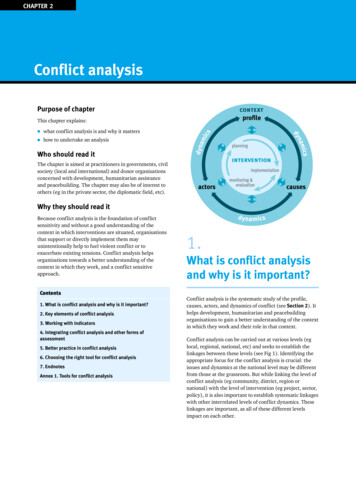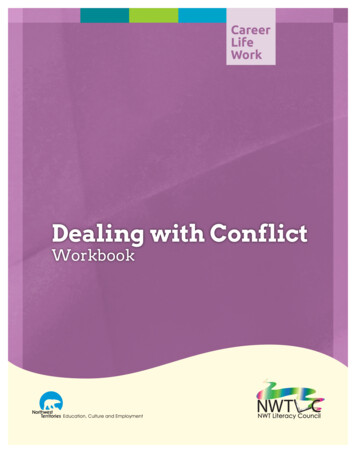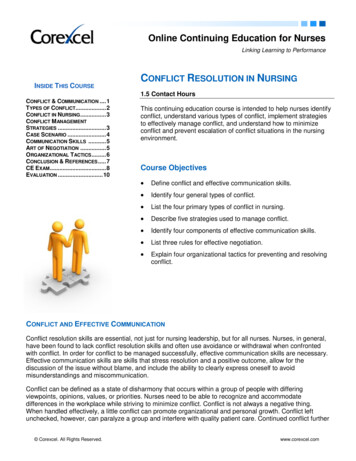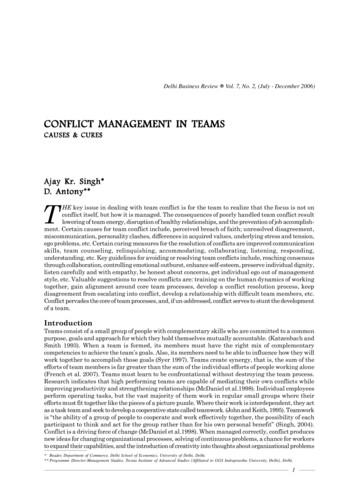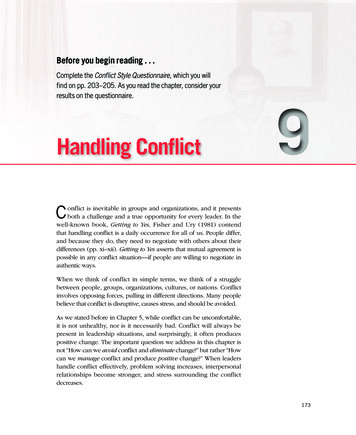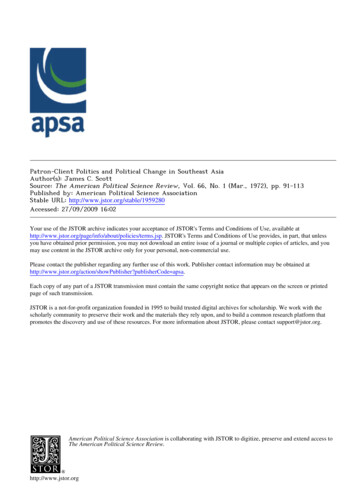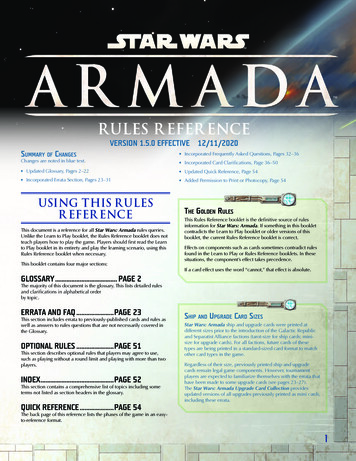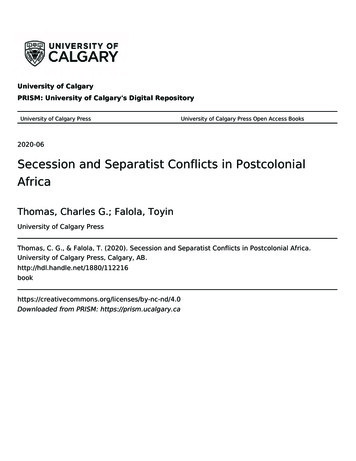
Transcription
University of CalgaryPRISM: University of Calgary's Digital RepositoryUniversity of Calgary PressUniversity of Calgary Press Open Access Books2020-06Secession and Separatist Conflicts in PostcolonialAfricaThomas, Charles G.; Falola, ToyinUniversity of Calgary PressThomas, C. G., & Falola, T. (2020). Secession and Separatist Conflicts in Postcolonial Africa.University of Calgary Press, Calgary, eativecommons.org/licenses/by-nc-nd/4.0Downloaded from PRISM: https://prism.ucalgary.ca
SECESSION AND SEPARATIST CONFLICTSIN POSTCOLONIAL AFRICABy Charles G. Thomas and Toyin FalolaISBN 978-1-77385-127-3THIS BOOK IS AN OPEN ACCESS E-BOOK. It is an electronicversion of a book that can be purchased in physical form throughany bookseller or on-line retailer, or from our distributors. Pleasesupport this open access publication by requesting that youruniversity purchase a print copy of this book, or by purchasinga copy yourself. If you have any questions, please contact us atucpress@ucalgary.caCover Art: The artwork on the cover of this book is not openaccess and falls under traditional copyright provisions; it cannotbe reproduced in any way without written permission of the artistsand their agents. The cover can be displayed as a complete coverimage for the purposes of publicizing this work, but the artworkcannot be extracted from the context of the cover of this specificwork without breaching the artist’s copyright.COPYRIGHT NOTICE: This open-access work is published under a Creative Commonslicence. This means that you are free to copy, distribute, display or perform the work as longas you clearly attribute the work to its authors and publisher, that you do not use this workfor any commercial gain in any form, and that you in no way alter, transform, or build on thework outside of its use in normal academic scholarship without our express permission. Ifyou want to reuse or distribute the work, you must inform its new audience of the licenceterms of this work. For more information, see details of the Creative Commons licence 0/UNDER THE CREATIVECOMMONS LICENCE YOUMAY: read and store thisdocument free of charge; distribute it for personaluse free of charge; print sections of the workfor personal use; read or perform parts ofthe work in a context whereno financial transactionstake place.UNDER THE CREATIVE COMMONS LICENCE YOUMAY NOT: gain financially from the work in any way; sell the work or seek monies in relation to the distributionof the work; use the work in any commercial activity of any kind; profit a third party indirectly via use or distribution ofthe work; distribute in or through a commercial body (withthe exception of academic usage within educationalinstitutions such as schools and universities); reproduce, distribute, or store the cover image outsideof its function as a cover of this work; alter or build on the work outside of normal academicscholarship.Acknowledgement: We acknowledge the wording aroundopen access used by Australian publisher, re.press, andthank them for giving us permission to adapt their wordingto our policy http://www.re-press.org
Secession andSeparatist Conflictsin postcolonial africaCharles G. Thomas and Toyin Falola
Secession andSeparatist Conflictsin postcolonial africa
AFRICA: MISSING VOICES SERIESTimothy Stapleton, Professor, History, University of CalgaryISSN 1703-1826 (Print) ISSN 1925-5675 (Online)This series addresses issues and topics that have been overlooked in political, social, andhistorical discussions about Africa.No. 1 Grassroots Governance?: Chiefs in Africa and the Afro-CaribbeanEdited by D.I. Ray and P.S. Reddy · Copublished with the InternationalAssociation of Schools and Institutes of Administration (IASIA)No. 2 The African Diaspora in Canada: Negotiating Identity and BelongingEdited by Wisdom Tettey and Korbla PuplampuNo. 3 A Common Hunger: Land Rights in Canada and South AfricaBy Joan G. FairweatherNo. 4 New Directions in African Education: Challenges and PossibilitiesEdited by S. Nombuso DlaminiNo. 5 Shrines in Africa: History, Politics, and SocietyEdited by Allan Charles DawsonNo. 6 The Land Has Changed: History, Society and Gender in Colonial Eastern NigeriaBy Chima J. KoriehNo. 7 African Wars: A Defense Intelligence PerspectiveBy William G. ThomNo. 8 Reinventing African Chieftaincy in the Age of AIDS, Gender, Governance,and DevelopmentEdited by Donald I. Ray, Tim Quinlan, Keshav Sharma, and Tacita A.O. ClarkeNo. 9 The Politics of Access: University Education and Nation-Building in Nigeria,1948–2000By Ogechi Emmanuel AnyanwuNo. 10 Social Work in Africa: Exploring Culturally Relevant Education and Practice in GhanaBy Linda KreitzerNo. 11 Secession and Separatist Conflicts in Postcolonial AfricaBy Charles G. Thomas and Toyin Falola
Secession andSeparatist Conflictsin postcolonial africaCharles G. Thomas and Toyin FalolaAfrica: Missing Voices SeriesISSN 1703-1826 (Print) ISSN 1925-5675 (Online)
2020 Charles G. Thomas and Toyin FalolaUniversity of Calgary Press2500 University Drive NWCalgary, AlbertaCanada T2N 1N4press.ucalgary.caThis book is available as an ebook which is licensed under a Creative Commonslicense. The publisher should be contacted for any commercial use which fallsoutside the terms of that license.Library and Archives Canada Cataloguing in PublicationTitle: Secession and separatist conflicts in postcolonial Africa / Charles G. Thomasand Toyin Falola.Names: Thomas, Charles G., 1979- author. Falola, Toyin, author.Series: Africa, missing voices series ; no. 11. ISSN 1703-1826Description: Series statement: Africa: missing voices series, ISSN 1703-1826 ;no. 11 Includes bibliographical references and index.Identifiers: Canadiana (print) 20190214708 Canadiana (ebook) 20190214775 ISBN 9781773851266 (softcover) ISBN 9781773851273 (Open Access PDF) ISBN 9781773851280 (PDF) ISBN 9781773851297 (EPUB) ISBN9781773851303 (Kindle)Subjects: LCSH: Secession—Africa—History—20th century. LCSH: Africa—History—Autonomy and independence movements.Classification: LCC DT30.5 .T56 2020 DDC 320.1/5096—dc23The University of Calgary Press acknowledges the support of the Government ofAlberta through the Alberta Media Fund for our publications. We acknowledgethe financial support of the Government of Canada. We acknowledge the financialsupport of the Canada Council for the Arts for our publishing program.Copyediting by Peter EnmanCover image by Magharebia, used under the Creative Commons License Attribution2.0 License en).This image has been lightly altered from the original. Original image can be found athttps://commons.wikimedia.org/wiki/File:Le Mali entame le dialogue avec lesTouaregs (6972875286).jpgCover design, page design, and typesetting by Melina Cusano
ContentsList of MapsviIntroduction1Part I: The Civil Secessions231The Secession of Katanga, 1960–1963392The Secession of Biafra, 1967–197067Part II: The Long Wars993The Anomaly of Eritrean Secession, 1961–19931154The Secession of South Sudan, 1955–2011157Part III: The New Wave of Secessions1895De Facto Secession and the New Borders of Africa:Somaliland, 1991–Present2036Transnational Communities and Secession: The AzawadSecessionists, 1990–1996 and Beyond231Conclusion: Secession and the Secessionist Motive intothe Twenty-first Century263Notes287Bibliography327Index341v
List of MapsAll maps by Nathan E. McCormack and Charles G. ThomasMap of Africa—Secession Case Studies Shown in WhiteviiMap of Congo and Katanga37Map of Nigeria and Biafra65Map of Ethiopia and Eritrea113Map of Sudan and South Sudan155Map of Somalia and Somaliland201Map of Mali and Azawad229viCharles G. Thomas and Toyin Falola
Map of Africa—Secession Case Studies Shown in WhiteCopyright 2014 Nathan E. McCormack and Charles G. Thomasvii
IntroductionThe African secessionist conflicts of the postcolonial era remain rare andin many ways exceptional phenomena, that have blended politics and violence in ways unlike any other struggles on the continent. The structureand goals of these conflicts have evolved over the course of four decades ofindependence and been continually shaped by the experience of the preceding separatist wars, the international reaction to their prosecution, andthe broader global political trends. The main undertaking of this volumeis to explain the historical context and precedents that have shaped theconcept and practice of secessionist conflicts in Africa from independenceto the present day.To accomplish this goal, this introduction lays a foundation for thehistory of secession in Africa. It begins with an explanation of the natural intertwining of politics and warfare on the African continent in termsof both external and internal state conflicts, including a discussion of theexceptional and evolving form of secessionist wars, and then proceeds to ageneral overview of what secession itself entails as well as its related termsof separatism and irredentism. Following this is a brief summary of themain theoretical conceptions of the motives behind secession in the world,with an eye toward what drives this form of violence against the state. Nextis a basic discussion of the relative absence of the secessionist motive inAfrica and the proposed reasons for this. Finally, the introduction endswith a description of the structure of the book and how it uses the historicalarc of secessionist conflicts in Africa to explain the anomalous structure ofsecession and separatism in terms of the African state.1
War and PoliticsAs clichéd as it may be to begin with a quotation from an eminent voicefrom the past, it seems appropriate to start this section with Clausewitz’sfamous observation that “war is the pursuit of politics by other means.”War is the ultimate expression of political violence, an organized effort todrive forward a political ideal, supported by a political body and carrying forth a conscious or unconscious ideology. Therefore, a war must ofnecessity carry a political goal within its execution, the grand strategy ofthe aggressor that then defines the rhetoric, structure, and execution ofthe violence, whether it be one of external projection of power against another state or an internal conflict advancing a particular political objective.Viewed in such a way, it is no surprise that Africa, which has seen suchpolitical turbulence beginning with its rapid decolonization, has also seena subsequent abundance of conflict. The African state, like any other state,creates and maintains its prerogatives by control of the means of violence,and in this sense all conflicts can and must be viewed in their politicalrelation to the states involved.This relation is readily apparent when one examines the various majorconflicts that have dotted the continent since independence. The most obvious of the struggles within Africa are those of state against state, whichdespite their visibility are generally rare upon the continent. These includethe formal conflicts between Ethiopia and Somalia over the Ogaden in1977–78, where two centralized and powerful states fought a conventionalwar over territory historically claimed by both nations. This conflict was followed in short order by the often overlooked struggle between Uganda andTanzania in 1979, where the Tanzania People’s Defence Force drove Amin’sUgandan Army from the Kagera salient and toppled the dictator’s regime.Beyond these eastern conflicts, the multiple wars between Libya and Chadin the 1970s and 1980s fall into this category. Qaddafi’s conventional Libyan forces were attempting to claim a strip of Chadian territory and wereultimately frustrated over the course of multiple incursions. The Horn evensaw what might be termed a continuation of an earlier conflict in the recentEthiopian-Eritrean War of 1998–2000, where the borders of the recentlyseparated states became the subject of a violent disagreement. Of course,dwarfing all of these, in both political meaning for the continent and scale,2Charles G. Thomas and Toyin Falola
were the wars waged between the white settler regimes in southern Africa, including South Africa and Rhodesia, against the Frontline States.1Beginning with the earliest liberation struggles in the 1960s through to themassive Battle of Cuito Cuanavale,2 these wars featured the military effortsof multiple independent African countries, including Tanzania, Zambia,Angola, and Mozambique, in a decades-long concerted conventional waragainst multiple South African and Rhodesian incursions. Despite theoften-fragile state structures of Africa, these states are more than capableof prolonged conflict in pursuit of their political ends.In state confrontations these political goals vary, but they still serve asthe guiding principle of the struggle. In fact, in these struggles it is alwaysprimarily a clash of opposing political beliefs or needs that drive each sideinto the conflict. For the Ethiopia-Somalia struggle it was competing political claims for the Ogaden, an Ethiopian region filled with ethnic Somalis.For the Tanzania-Uganda War it was the political struggle for control ofthe Lake Victoria region and the stability and security of either regime.Amin needed a war and conquests to cement his increasingly tenuouscontrol of his state, while Nyerere’s Tanzania could never achieve its goalsof security and peace with Amin’s regime at its borders. The Chad-Libyawars were fought for the glorification of Qaddafi’s Libya at the expense ofthe Chadian government and for the sovereignty over the Aouzou Strip innorthern Chad, which Libya claimed due to a previous unratified colonial treaty. Within the clashes between the Frontline States and the settlerregimes, it was the political question of decolonization and majority ruleversus South Africa and Rhodesia’s desire to secure their minority regimesthat drove the conflict. All of these conflicts were the extension of frustrated political goals of the aggressors clashing with the status quo of theiropponents. What mainly sets them apart from the greater proportion ofAfrican conflicts is their method of prosecution. Whereas the vast majorityof African conflicts involve one or more stateless actors, out of definitionthese state confrontations involved developed logistical systems and complex political structures on both sides. This altered the conflict from one involving a protracted guerrilla struggle to a conventional war between twodeveloped regular militaries. The simple fact that it is an external conflictfor two states determines both the nature of the conflict’s interaction withthe states and the methods of its waging. This dynamic alters considerablyIntroduction3
when one considers the wide variety of internal state struggles, which radically outnumber the external struggles since independence.3Let us examine one particular family of conflicts that have emerged inAfrica in the past decades. This specific strain of conflicts is best viewed asthe liberation struggles of the former colonies that had not yet been grantedtheir own self-governance. Perhaps the first in this category was the MauMau in Kenya, an insurgency meant to advance the political goals of theKikuyu in the face of an unfair system of colonization. The scale wouldonly increase from there, including the brutal struggle in Algeria thatbegan to unravel the French Empire in Africa, although the French sphereof influence was somewhat preserved due to their own political manoeuvring. The greatest of the decolonization struggles took place in the regionsadministered by the Portuguese, where the colonies of Guinea-Bissau, Angola, and Mozambique all saw protracted struggles against a formal colonial power. These wars lasted from the early 1960s until 1974, when theCarnation Revolution overthrew the Portuguese government. The trailingconflicts of this sort were those of the anomalous former British coloniesof Rhodesia and apartheid South Africa. Rhodesia first committed its ownact of political violence in its Unilateral Declaration of Independence in1965, severing itself from the British sphere of influence. From this pointon, a struggle was waged by the white settler population against the blackAfrican popular fronts of ZANU and ZAPU, both of which clamoured formajority rule, the last step in decolonization, which finally came in 1980.As for South Africa, the struggle itself is hard to categorize because of itsstrange history. While the struggle of the ANC and Pan-African Congressgroups against the apartheid government may be viewed as the struggleagainst the colonizers who had created an oppressive imperial state, theymay also be viewed as reform struggles, which will be covered shortly.4 Ineither case, the political aspirations of those involved were clear and thestruggle was tailored to attain those goals.In the liberation conflicts in Africa, the political goal that defined themwas obvious: the national self-determination of a colonized people, freefrom either the control or even nominal influence of their former colonialpower. Put simply, these were struggles for freedom from an establishedforeign state structure, and as such the struggles were often conductedagainst an opponent superior in arms, capital, and training. This meant4Charles G. Thomas and Toyin Falola
that the primary method of waging war was what would be defined by MaoTse-Tung as a protracted conflict, one where the nascent nationalist forcesavoided direct confrontation with the superior foe and instead concentrated on sapping the latter’s will to fight until political circumstances forcedan end to the conflict or the balance of power had shifted so as to allow aconventional war of manoeuvre to commence. To effect this struggle, theliberation movements needed to create a political framework that wouldserve as an alternative to the colonial rule and use this limited example asa symbol to gain popular approval. The political goal had to be compellingenough to draw in the populace in sufficient numbers to affect the protracted struggle and to eventually place that political structure into power overthe newly freed nation itself. In short, liberation conflicts are defined by thepolitical goal of freedom from an outside colonizer and are structured insuch a way as to promote a domestic national government as both the basisfor struggle and the end goal itself.A second prominent strain of internal conflict on the continent is thoseconflicts waged to alter the ideology or form of government in control ofthe state. These wars have happened all over the continent, with the mostcommon examples often following in the wake of the decolonization itself,as internal groups seek their own advantage in the new power structure.The radical Lumumbists of the Stanleyville faction in the Congo in the1960s stand as an excellent example of these, rejecting the central Leopoldville government’s sovereignty and demanding acceptance of their ownpower. In addition, the long civil wars faced by both Angola and Mozambique following their independence struggles may be characterized as reform conflicts, as RENAMO in Mozambique and UNITA and the FNLAin Angola all were fighting against the domestic power structures thathad ascended following the liberation struggles in those lusophone countries.5 Within the greater struggles in Ethiopia in the late 1970s throughthe 1990s, there were a number of reform conflicts that became embroiledin the greater Eritrean conflict against the ruling Derg, most notably thestruggle of the Tigray People’s Liberation Front. As a final and perhaps theclearest example, there are the myriad groups that struggled within Uganda after the fall of Idi Amin, with groups as diverse as Alice Lakwena’s HolySpirit Mobile Forces and Yoweri Museveni’s National Resistance Army allseeking a hold on the domestic power structure. As long as there have beenIntroduction5
independent domestic political power structures in Africa, there have beenarmed groups willing to dispute these structures.Much as with the liberation struggles, the political goals of the reformconflicts are fairly obvious. These struggles are defined by the involvementof groups seeking the reform or replacement of the recognized state apparatus. In many ways, they are the cognate of the liberation struggles, exceptthat they are political violence aimed at the postcolonial state as opposedto the colonial empire. As such, the same structures and practices are oftenrequired of them as of the national liberation movements. Due to the 1963Organization of African Unity charter, which placed the sovereignty of therecognized government above reproach, the reform movements were oftencut off from external aid and thus were at an even greater disadvantagethan the liberation fronts had been (although there are exceptions, such asRENAMO and UNITA’s aid from South Africa). This made the protractedstruggle even more attractive following the international acceptance of thefreed African nations and their sovereignty. Still, just as in the liberationstruggles, the political goals of the reform movements needed to be compelling enough to enlist popular support, although as can be seen by theexamples, the results of both the political programs and the military operations behind them varied considerably. However, to put a simple definitionon them, the reform conflicts were internal popular struggles intended toalter the domestic political situation to one preferred by the aggressors,whether they were identified by ethnicity, ideology, or religion.Both of these forms of conflict, along with the other plethora of conflicts featuring violence of the populace against the state,6 feature a varietyof commonalities. Both, obviously, must take the form of stateless massmovements. This is because the participants of the struggles already existwithin a state that they wish to politically control and transform as opposed to dismantle. With the success of their goal, they move from massmovement to state government. Both enter the realms of African warswhen the political goal may only be reached with the application of violence, and as the violence spreads, it moves from protest to conflict to war.As the previous world independence struggles had shown, the most efficacious method of pursuing these wars was that of a protracted guerrillastruggle. As such, both of these types of conflicts, having similar origins inmass discontent with the state structures and similar goals of overthrowing6Charles G. Thomas and Toyin Falola
these structures, took on similar forms and similar methods and often sawsimilar outcomes: the independence of African states or the protractedstruggle between an African state and its dissidents. However, there was athird major struggle throughout this period that involved internal violenceagainst the state, one that took on its own form and own unique structures,and one that was affected far more by international context and events thaneither of the previous two. These were the secession struggles of Africa.The secession struggles must be viewed separately from the othertypes of internal African conflicts for a variety of reasons. The first mustbe that their political basis is distinctly different from that of their two internal compatriots. Whereas, as mentioned, liberation and reform conflictslooked to seize the control of the state apparatus and thereby gain sovereignty for their faction, secession conflicts looked to sever it completelyand form their own sovereign body separate from the original. Whereasthe previous two looked for state domination, secession struggles lookedfor state division. Of course, since the conflict itself is simply the pursuitof the political goal by other means, the alteration of political goals meantan alteration in structures and methods of conflict. One may look downthe list of liberation and reform conflicts and see stateless mass movementafter stateless mass movement, each pursuing its own protracted guerrillastruggle against the state itself. These may exist and may pursue their goalsthrough those methods because their success means they take on the newlyconquered state’s legitimacy and sovereignty in the global community. It isnot so simple for secessionist movements. Secessionist states are dependentupon diplomatic recognition of their existence for success, something thatdoes not happen simply with a proclamation of independence. As such,their relationship both with their “host” state and the community of statesat large is even more complex than that of liberation or reform struggles.They must pursue their conflicts in such a way as to gain the local controlover the populace or territory they wish to rule and at the same time existas a recognizable state that may be accepted into the greater global community. This is an extremely ambitious and difficult political goal, and theimportance of the resulting structures and methods of secession take onincreased dimensions.It is in these structures and methods that we see the second major divergence from the other internal African conflicts. The liberation and reformIntroduction7
conflicts within African states could look to previous conflicts around theworld that achieved similar goals. For liberation struggles, the Indochinawars and the struggles against the Japanese in Southeast Asia during theSecond World War gave an obvious example, one of supposedly undeveloped people besting the industrialized world through the use of guerrillaand protracted warfare and a strong conception of national identity. For reform conflicts, the same examples offered inspiration, as did Mao’s victoryover the Nationalist Chinese despite the massive amount of American aidgiven to Chiang Kai-Shek’s government. The postwar anti-colonial struggles allowed all colonized people to see the possibilities of resistance andrevolution. However, for secession there was little precedent established.The European examples such as Belgium happened in a completely different century and in very different circumstances that bore little resemblanceto the postcolonial world. The rest of the world offered no parallel secessionexamples at the time. As such, the African secession conflicts were pursuedin a disjointed and evolving way, changing their form as the circumstancesaltered and the political goals the protagonists sought proved impossible toattain. It is this changing form that this volume is intended to address, bymapping both the attributes of the secessionist struggles and the contextsthat shape them.Secession ItselfTo begin, it is perhaps most appropriate to discuss in depth exactly what secession itself is. To further refine the earlier definition given, secession is agroup or territory’s political removal from a sovereign and recognized stateand establishment as a distinct sovereign body. What is especially important within this definition is the creation of a new and recognized sovereign body, which is the key component of understanding secession withinthe greater body of separatist initiatives. While secession may be achievedthrough a variety of means, it is rare for peaceful secessions to occur, aseven those such as the separation of Somaliland occur within the contextof a greater struggle within the original sovereign body.7 This is generallyunsurprising, as the removal of any members of the populace or body ofterritory diminishes the state and may be viewed as violence against the8Charles G. Thomas and Toyin Falola
state itself. It is in this complete removal that secession separates itself fromthe concept of separatism, of which it is a subcategory and related concept.Separatism seeks the separation of a demarcated group, be it ethnic,cultural, religious, or racial, from the pre-existing political body, but notnecessarily its own recognized sovereign body completely divorced fromthe previous state. Instead separatism may simply seek limited or full autonomy under the existing political group without going so far as to seektotal separation. This is a far less extreme option in the eyes of the existingstate from which the group seeks to separate, and it means that separatismhas the far greater potential of success, as the original host state may actually find the new arrangement advantageous compared with its previoussystem, or at least less harmful than the whole secession of a people orregion. Interestingly enough, while all secessions themselves are separatistin nature, all separatisms are not necessarily secessions. They are simplydefined by the end relationship between the state and the separating region.Lastly, in terms of secession and separatism, it is important to discussthe related concept of irredentism, which is a specific form of separatismthat seeks the total cleavage of a people or region from a pre-existing political body but does not create a new distinct sovereign body. Instead, theseparating group is attached to or absorbed within another pre-existingpolitical body, often one that can claim ethnic, religious, racial, or even political commonalities. Therefore, while irredentism seeks the extreme measure of complete withdrawal from a state, it does not meet the conditionsof secession as it does not form its own new sovereign state and insteadacquires the legitimacy and sovereignty of its new host state. Irredentismhas been especially prevalent in recent years where ethnic nationalism hasre-emerged and the idea of greater ethnic homelands and nation-stateshave become acceptable. It often takes the form of claims of a greater homeland of peoples containing the ethnic community the presumed host staterepresents.Of course, all three of these concepts intersect in a variety of ways.As noted, secession is itself separatism with the distinction simply beingth
9781773851303 (Kindle) Subjects: LCSH: Secession—Africa—History—20th century. LCSH: Africa— History—Autonomy and independence movements. Classification: LCC DT30.5 .T56 2020 DDC 320.1/5096—dc23 The University of Calgary Press acknowledges the support of the Government of Alberta through the Alberta Media Fund for our publications.
